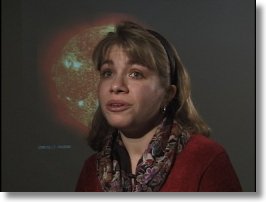|
B a r b a r a T h o m p s o n Astrophysicist NASA Goddard Space Flight Center SOHO Lost and Found
(After launch and during regular operations) every night I went home to check in to make sure (SOHO) was alright. I'd wake up in the morning before I'd drive to work, I'd check in to make sure everything was OK. It became a part of your life, you're very concerned about it, and you take a personal interest in its health. So when we lost the spacecraft, something I actually really cared about, not just intellectually, but personally, was gone. When SOHO first failed, you might say I went through the "7 stages of grief" or however counselors call it. For a while, it was pretty bleak. The most significant impact for me was that our global coronal dynamics monitor (CDS) was gone. I used to be able to log in every morning and see what the Sun was doing. Now it was not as easy. There are other missions that were very good at this, but for me SOHO made all the other missions complete. Without SOHO observations I did not feel that I was really as familiar with the Sun-you really become connected with the environment that you are studying, especially when the solar environment is so well linked with the Earth's environment. It was very tough to lose that. |
